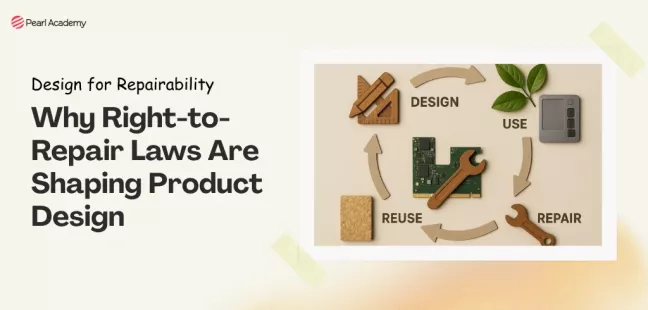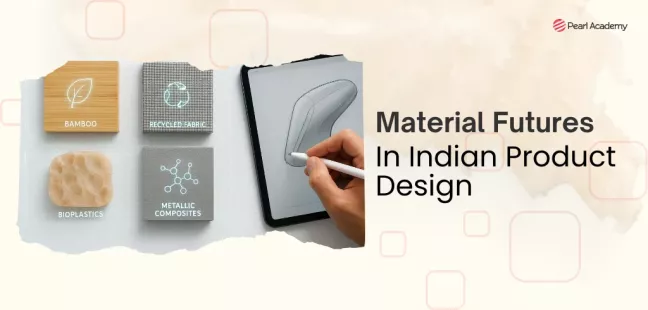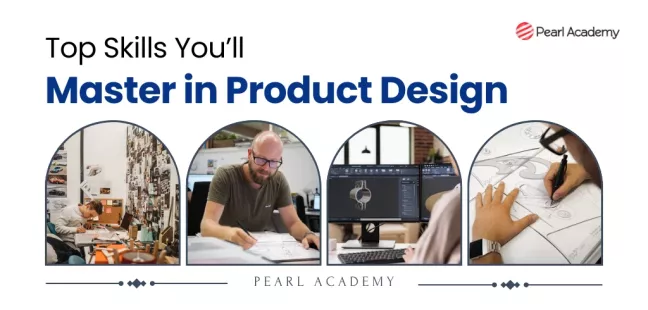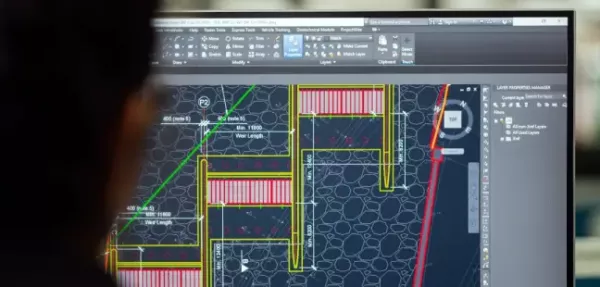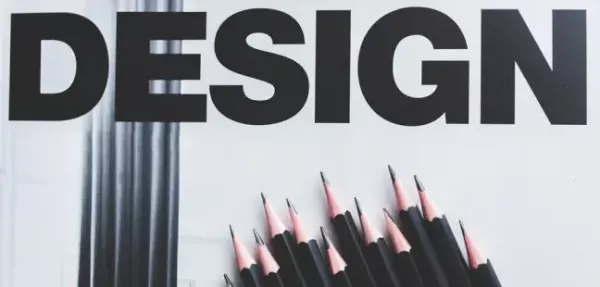Product Design Colleges to Consider in India in 2026
- Editorial Team
- Published 26-Aug-2025

In 2026, India’s product design education landscape is evolving rapidly. We live in an age of fascination, innovation, and diversity, where every day a new product is launched that goes beyond utility, offering sleek looks, user-friendly interaction, and memorable experiences. With industries embracing AI, sustainability, and digital fabrication, the demand for skilled product designers is at an all-time high. A product today is not just about function; it’s about the experience it delivers, and that’s exactly where the role of a product designer becomes crucial.
If you aspire to step into this dynamic field, choosing the right college will define your creative and professional journey. This blog highlights the top 9 product design colleges in India for 2026, their courses, fees, curriculum, placements, and unique advantages, to help you make an informed choice.
Become future-ready with our Product Design Programs
Know MoreCriteria for Selecting Premier Product Design Colleges
When identifying top-tier institutions for product design in India, the following factors are central:
- Academic Rigor & Pedagogy: Balanced blend of theory, studio practice, design thinking, and research.
- Faculty Expertise: Faculty drawn from academia, industry, and research spheres.
- Infrastructure: Access to prototyping labs, digital tools, rapid modeling, and collaborative spaces.
- Industry Connectivity: Collaborations, internships, placements, and competition exposure.
- Accreditation & Prestige: Government recognition, national importance, and global rankings.
- Admission Selectivity & Cost: Entrance rigour, fees, and scholarship availability.
Being rigorous in your identification and selection will help you choose best colleges for product design in India.
Top Product Design Colleges in India 2026
The gateway to becoming a product designer lies through studying product design courses in India. A carefully curated syllabus, strong infrastructure, cost-effective fees, robust placements, and experienced faculty can help you achieve your dream of becoming a successful product designer.
With rapid advancements in AI, sustainability, and digital fabrication, choosing the right institution has become critical in 2026. This academic guide evaluates the top product design colleges in India, offering insights into curricula, pedagogy, industry linkages, fees, placements, and emerging trends.
Listed below are best product design colleges in India you can enrol at to embark on a journey of innovation, creativity, and design.
1. Pearl Academy (B.Des. & M.Des. in Product Design)
Overview
A modern design institution with campuses in Delhi-NCR and Mumbai, Pearl Academy blends academic rigour with industry-readiness.
B.Des. in Product Design — Course Highlights
- Duration: 4 years; Eligibility: 10+2.
- Curriculum: Project-driven and hands-on pedagogical design that melds design thinking, product innovation, design management, and technology-forward tools.
- Applied focus on sustainability, global trends, and 21st-century skills (emotional intelligence, critical thinking, financial literacy) under its ‘School for Life’ ethos.
- Partnerships with SPIT and CollabTherapy provide advanced studio infrastructure and collaborative learning.
- Strong faculty guidance—led by ex-IIT heads—and frequent student participation in global competitions like Taiwan International Student Design Competition and UX Design Awards.
- Fee Structure (approximate): One-time ₹82,000; Semesters ₹2.75 lakhs each.
- Salary Prospects: Placement packages ranging ₹4–15 LPA, with sectors spanning tech, healthcare, FMCG, and more. To prepare for placement success, explore our guide on product design interview questions and answers.
M.Des. in Product Design
- A 2-year postgraduate journey designed for advanced learners, emphasizing technological adeptness, social consciousness, and market-oriented innovation.
- Curriculum features immersive experiences, practical workshops, and strong industry exposure.
Why Consider Pearl Academy
- Contemporary curriculum merging academia with real-world technologies and global exposure.
- If you are evaluating creative institutions, here are the top reasons to choose Pearl Academy for your career.
- Cost-efficiency, relative to legacy institutes, yet competitive in outcomes.
2. National Institute of Design (NID), Ahmedabad
Overview & Reputation
Established in 1961, NID is India's premier design institution, recognized as an Institute of National Importance under the National Institute of Design Act, 2014. It spans multiple campuses, including Ahmedabad, Gandhinagar, and Bengaluru.
Programmes
- B.Des in Product Design: A highly competitive 4-year undergraduate programme emphasizing ergonomics, materials, aesthetics, and user-centric design.
- M.Des in Product Design: A 30-month postgraduate course with limited intake and a strong focus on advanced design thinking.
Pedagogy & Outcomes
- NID adopts a “hands‑on, minds‑on” model grounded in live projects and interdisciplinary learning.
- Notable for its intensive studio culture, innovation labs, and high placement rates (average ₹9–12 LPA).
- Entrance via NID‑DAT reflects extremely high selectivity.
Why Consider NID
NID stands out for its academic legacy, state-backed recognition, cross-disciplinary learning environment, and immersion in core design values. Its rigorous process ensures graduates are industry-ready and design leaders of tomorrow.
3. National Institute of Fashion Technology (NIFT)
Overview
Founded in 1986, NIFT is renowned primarily for its fashion-oriented programmes. While it’s not traditionally central to product design, several pathways align closely with this discipline.
Programmes Relevant to Product Design
- While NIFT does not offer a stand-alone Product Design course, related streams such as Accessory Design and Leather Design incorporate product-oriented design thinking.
Reputation & Placement
- NIFT's brand equity and industry linkages make it a strong option for design aspirants, with high placement visibility across design sectors.
Why Consider NIFT
For students exploring product-adjacent paths—such as accessories, leather goods, or wearable objects—NIFT offers structured, trend-led programmes backed by industry alignment and pan-India presence.
4. Indian Institute of Art and Design (IIAD), New Delhi
Overview
A newer but progressive design school established around 2015, IIAD emphasizes experiential and industry-centric design education.
Programme
Offers a 4-year undergraduate Product Design course featuring internships and strong industry integration.
Highlights
- Focused on hands-on learning backed by academic partnerships.
- Fees: Approximately ₹5.47 lakhs per annum.
Why Consider IIAD
For students seeking a newer, design-forward institution with a digital-age ethos and project-based curriculum.
5. MIT Art, Design & Technology (MIT-ADT) University, Pune
Overview
MIT-ADT University, situated in Pune, is a part of the larger MIT Group of Institutions, which has a strong legacy in design, engineering, and technology. The university’s MIT Institute of Design (MIT-ID) is one of the country’s leading private design schools, consistently ranked among the best for product design.
Programmes
- B.Des in Product Design (4 years)
- M.Des in Product Design (2 years)
The programmes emphasize a balance between conceptual thinking, practical prototyping, and design entrepreneurship.
Highlights
- Annual fees of approximately ₹6.52 lakhs make it one of the more premium private design schools in India.
- Curriculum integrates design thinking, research, sustainability, and digital tools like CAD, AR/VR, and rapid prototyping.
- Strong alumni network and placements with firms in FMCG, automobile, and consumer technology sectors.
Why Consider MIT-ADT
Students benefit from the blend of traditional product design pedagogy and modern digital design technologies, making graduates well-prepared for both creative industries and start-ups.
6. Srishti Manipal Institute of Art, Design and Technology, Bengaluru
Overview
Founded in 1996, Srishti Manipal has gained an international reputation for its interdisciplinary approach to design. It is now part of the Manipal Academy of Higher Education (MAHE), adding academic credibility.
Programmes
- B.Des and M.Des programmes that allow flexibility to specialize in Product & Industrial Design, integrated with other domains like sustainability, technology, and craft.
Highlights
- Curriculum focuses heavily on innovation, experimentation, and social impact.
- Unique pedagogical model that encourages collaboration with NGOs, government bodies, and international partners.
- Known for a liberal, experimental, and research-driven environment rather than rigid structures.
Why Consider Srishti Manipal
For students who value freedom, interdisciplinary exploration, and global collaborations, Srishti Manipal offers a distinctive learning environment unmatched in India’s design ecosystem.
7. Unitedworld Institute of Design (UID), Karnavati University, Gandhinagar
Overview
UID, under Karnavati University, has quickly risen as one of India’s largest private design schools. Its state-of-the-art campus in Gandhinagar is recognized for advanced workshops, prototyping labs, and global-standard facilities.
Programmes
- B.Des in Product Design
- M.Des in Product Design
- Specializations across Industrial Design, Lifestyle Products, and Mobility Design.
Highlights
- Heavy investment in infrastructure: 3D printing, CNC machines, model-making studios.
- Collaborations with international universities ensure student exchange opportunities.
- Known for design competitions and hackathons that prepare students for real-world innovation.
Why Consider UID
UID is an excellent option for students seeking a large, modern, and globally connected campus with diverse opportunities for experimentation in product and industrial design.
8. ARCH College of Design and Business, Jaipur
Overview
ARCH, established in 2000 in Jaipur, has positioned itself as a design and business-oriented institution. It focuses not only on creative training but also on design entrepreneurship.
Programmes
- B.Des in Product Design
- Postgraduate diplomas in Product Innovation & Entrepreneurship.
Highlights
- Offers a mix of design practice and business acumen, preparing students for start-ups and entrepreneurial ventures.
- Strong emphasis on craft-based design innovation, leveraging Jaipur’s artisanal heritage.
- Active industry collaborations in lifestyle products, home décor, and furniture design.
Why Consider ARCH College
Students looking to combine product design with business and entrepreneurship will find ARCH’s approach especially compelling, particularly in the context of India’s growing creative start-up ecosystem.
9. IDC School of Design, IIT Bombay
Overview
The IDC School of Design, part of the prestigious IIT Bombay, is one of India’s oldest and most respected design schools. Though primarily positioned as an industrial design hub, it directly overlaps with product design education.
Programmes
- B.Des (4 years)
- M.Des (2 years)
- PhD in Design
Specializations include Industrial Design, Communication Design, Animation, and Interaction Design.
Highlights
- Being part of IIT Bombay, IDC offers access to cutting-edge technology, interdisciplinary collaborations, and research ecosystems.
- Strong focus on design research, ergonomics, and usability engineering.
- Graduates enjoy excellent placement opportunities in multinational companies, R&D labs, and tech firms.
Why Consider IDC IIT Bombay
IDC is best suited for students who want to combine deep design expertise with engineering rigor and research orientation, offering unparalleled prestige and global recognition.
Product Design Colleges - Key Comparison
India’s best product design colleges pair studio-heavy learning with prototyping labs, industry mentors, and portfolio-driven admissions. For 2026, shortlist Pearl Academy (B.Des/M.Des), NID, IDC-IIT Bombay, MIT-ID, Srishti Manipal, UID, IIAD, ARCH, and product-adjacent tracks at NIFT. Compare entry paths, focus areas, and campus strengths below.
| College | City / Network | Flagship program(s) | Known for | Typical entry path* |
| Pearl Academy | Delhi-NCR, Mumbai | B.Des Product Design, M.Des Product Design | Project-driven, School for Life, industry collabs (SPIT, CollabTherapy) | Institute assessment + portfolio + interview |
| NID | Ahmedabad + campuses | B.Des / M.Des in Product Design | Studio culture, national prestige | NID DAT + studio tests/interview |
| IDC, IIT Bombay | Mumbai | B.Des / M.Des / PhD | Engineering rigor + design research | UCEED (B.Des), CEED (M.Des) + admission rounds |
| MIT-ID (MIT-ADT) | Pune | B.Des / M.Des Product Design | Prototyping, AR/VR, CAD, design entrepreneurship | Institute test/portfolio + interview |
| Srishti Manipal | Bengaluru | B.Des / M.Des (Product & Industrial pathways) | Interdisciplinary, social impact | Institute process + portfolio |
| UID (Karnavati Univ.) | Gandhinagar | B.Des / M.Des Product Design | Large labs, 3D printing/CNC, hackathons | Institute process + portfolio |
| IIAD | New Delhi | B.Des Product Design | Experiential learning, internships | Institute test + portfolio |
| ARCH | Jaipur | B.Des Product Design; PG diplomas | Design + business, craft ecosystem | Institute process + portfolio |
| NIFT (adjacent) | Pan-India | Accessory / Leather Design | Product-adjacent, fashion industry ties | NIFT entrance + rounds |

Student Guidance Center: Our Counselors are Just a Click Away.
Conclusion
As India’s design ecosystem matures in 2025, students have access to a diverse range of product design colleges that blend creativity, technology, and industry relevance. From legacy institutions like NID and NIFT to forward-looking schools such as Pearl Academy, IIAD, UID, and IDC IIT Bombay, each offers unique pathways to becoming a future-ready designer. The choice ultimately depends on whether a student seeks research-led rigor, industry integration, or entrepreneurial innovation. What remains constant, however, is the rising demand for skilled product designers who can shape sustainable, user-centric solutions for a rapidly evolving world.
Tags
- #Product Design
Pearl Admission Enquiry
Subscribe to Pearl Blogs
By clicking the "Subscribe" button, I agree and accept the privacy policy of Pearl Academy.









